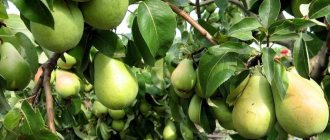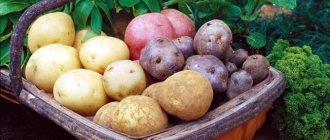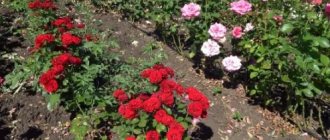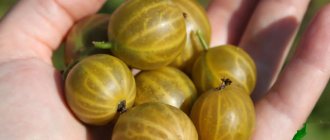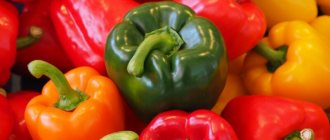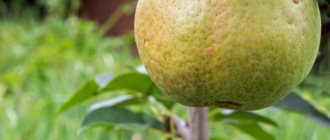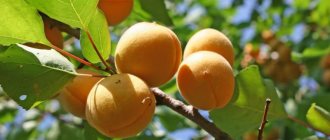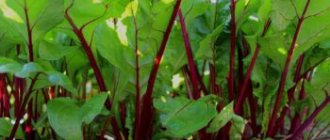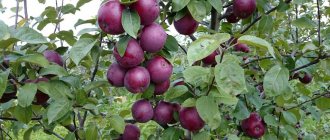Benefits of dwarf pears
Pears are usually very tall. They take up a lot of space in the garden. Therefore, placing several varieties can be problematic. They begin to bear fruit very late, at 5-7 years. And when the tree grows and there are a lot of fruits, another problem arises: it is difficult to remove them from a great height. It turns out, as in the famous riddle: a pear is hanging - you can’t eat it. When treating trees with various preparations, it is difficult to reach the top.
Dwarf pears do not have all these disadvantages. Advantages:
- They are small in stature.
- They take up little space.
- They begin to bear fruit quickly, within 2-3 years.
- Harvesting dwarf pears is easy.
- It is easier to carry out treatment against diseases and pests.
On one hundred square meters of land you can place 20-30 dwarf pears. While the usual strong-growing ones fit there at best 6 pieces.
But maybe the harvest from them will be less than from one large one? Perhaps if you add the weight of the fruit that fell from the tree and broke. And if you take those that you pick from an ordinary pear using a stepladder, then the weight of the fruits from dwarf trees may be greater. From one such pear they harvest from 3 to 8 kg of fruit.
In addition, on a vigorous pear there are usually fruits of one variety, but several dwarf ones can be planted in this area.
Features of planting and care
An area with loose soil and a small amount of clay is allocated for pears. Such a kidney allows air to pass through well and also retains moisture. The place should be well lit, without drafts. Planting is carried out both in the fall, until mid-October, and in the spring, in the second half of April.
A couple of weeks before planting, it is necessary to prepare a hole - 45 cm deep and 100 cm wide. A nutrient mixture is added to it; for this, combine:
- 1 bucket of rotted manure;
- 1 bucket of peat;
- 200 g of ash.
Planting process:
- Then everything is covered with dug up soil so that the rhizome does not come into contact with the fertilizer.
- A stake is driven into the center of the hole, which will serve as a support for the seedling - about 1–1.5 m high.
- A young plant is placed nearby and its roots are straightened.
- Fill the remaining space with soil.
- Then a circle around the trunk is formed and 2 buckets of water are added to it.
- When the liquid is absorbed, the area around the tree is mulched - sprinkled with fine peat or sawdust, and the seedling is loosely tied to a peg.
Video: instructions for planting a pear seedling
The plant is watered several times a season. They begin after the pear has bloomed - usually this process occurs in April - May. Depending on the age of the tree, the following is added to each m²:
- 1–2 years – 10–15 l;
- 3–5 years – 30 l;
- over 6 years old - 40–50 liters.
Irrigation is also carried out during the formation and filling of fruits.
The last time moisture is added is in the fall, after the tree has shed its leaves. After each such procedure, it is necessary to loosen the soil, while simultaneously removing weeds. Feeding is applied from the second year of growth. The event is held in autumn and spring. Thus, organic substances are added every three years, but mineral substances are added annually.
In the spring, the procedure is carried out in three stages:
- during the period of kidney swelling;
- during flowering;
- after flowering.
- 200 g magnesium sulfate;
- 10 liters of water.
During this period, nitrogen-containing substances are added, for example, an infusion of bird droppings at the rate of 500 g of active substance per 10 liters of water.
In the summer, two more feedings are carried out - in June and July. In this case, spray the plant with the following solution:
In early spring, before the beginning of the growing season, it is necessary to prune the garden. It is important that at this moment the temperature is above +5°C. Young seedlings must be shortened by 25% of their length for active crown growth. As for mature trees, they need to thin out the crown by removing branches growing at an acute angle to the trunk.
All cut areas are treated with garden varnish or oil paint.
Growing dwarf pears
Quince, which serves as the basis of the dwarf pear, does not tolerate severe frosts. Therefore, when planting, the entire lower part, up to the grafting site, must be hidden underground. In this case, it will survive in severe frost in the absence of snow cover.
Irga and cotoneaster are not afraid of frost. Therefore, they are used as a rootstock for the northern gardening zone. You just need to leave some branches of the plant ungrafted. They will supply the pear and the entire plant with photosynthetic products. True, after a few years the scion will significantly exceed the rootstock in diameter.
Using cotoneaster as a rootstock prolongs the life of pears. They can bear fruit for up to 30 years or more, giving yields of up to 30 kg. But such cases are rather the exception.
The soil for growing dwarf pears must be fertile. It can be black soil, sandy loam or chestnut loam. Feels good on soddy-podzolic lands. Will not grow in salty soils.
The advantage is that the close occurrence of groundwater will not be destructive for trees.
The roots of the dwarf pear are located in the upper layers. Trees need to be watered frequently. This can be considered a disadvantage of the dwarf pear.
How to care for the vaccine
Typically, the first signs that the vaccinations have taken place can be seen after 3 weeks. Branches that will grow on the rootstock must be removed.
It is also necessary to ensure that the material that strengthens and connects the rootstock and scion is not overtightened; it will need to be loosened in a timely manner.
Caring for self-grafted trees is no more difficult than caring for those purchased and planted on the site. Only, if you don’t want to do the grafting yourself, when purchasing, you need to carefully examine the place where the scion and rootstock are connected, so that there are no signs of rot.
Compatibility of pear with rootstock
You might think that with the beginning of the era of dwarf trees, any variety of pear could be grafted onto a quince and get a short tree. But it is not so. Some varieties are not compatible with quince. Dwarf pears are widespread - varieties Chizhovskaya and Sverdlovchanka.
The compatibility of pears with shadberry is much better than with cotoneaster. Many well-known varieties do not take root on it. Therefore, experienced gardeners advise using an intermediate rootstock compatible with it to grow pears of these varieties on cotoneaster.
Accommodation in the garden
Typically, a garden contains trees of varying heights. When planning their placement, you need to place dwarf pear seedlings and bushes in the southern and eastern parts. Plant semi-dwarf ones behind them, and vigorous ones in the northern part. If the garden is already formed, you need to see which tall trees can be sacrificed. Another option is to use them for rejuvenation. Then the garden will become much brighter. And there will be more space.
Dwarf pears are used for planting between rows of tall tree varieties before they grow. During the years before they reach their maximum height, dwarf pears will need to be removed.
Dwarf trees need plenty of sunlight. But sometimes it can turn from a plant’s friend into its enemy. In early spring, tree bark may suffer from sunburn. To prevent this from happening, with the first rays of the spring sun, the tree bark is treated with lime. Too high temperatures also harm trees. If the temperature exceeds 30 degrees, the trees do not do well. Fruits may get burned.
What is a rootstock?
For vaccination use:
- scion - the upper part of the future plant, a branch or bud of the desired variety, which will provide the desired appearance of the leaf, flower and fruit;
- rootstock - the lower part that will give the new plant roots and trunk.
The rootstock affects the quality of nutrition and the characteristics of the root system, transfers to the new plant its resistance to external factors (frost, drought, disease). For the rootstock, you can use an already mature tree that does not satisfy the quality of the fruit or yield.
In nurseries, various types of rootstocks are specially grown, both for fruit and ornamental crops. Scientists conduct research to find the best compatibility between specific species, cultivars, and rootstocks to produce trees and shrubs with desired characteristics. Did you know? The Russian breeder I.V. Michurin grafted plants in the garden already at the age of eight, and during the years of managing the nursery, he independently forged and soldered garden tools in a furnace he designed.
Rootstock grafting is performed for the following reasons:
- for propagation of varieties;
- for growing heat-loving species in other climatic zones;
- to preserve the variety in case of death of the mother plant.
Varieties of dwarf pears
What are the best dwarf pears to grow? Varieties must be selected that are zoned. They must be frost-resistant and be exposed to various diseases as little as possible.
All varieties of pears are delicious. But they need to be planted so that the fruits ripen at different times. This will make it possible to extend the period of consumption of these tasty and healthy fruits.
A couple of summer varieties and three autumn varieties are placed in a small area. There should be twice as many winter ones. After all, the period of consumption of harvested fruits is much longer than the time they are on the tree.
In any garden, it is enough to allocate up to 10 percent of the area for summer gardens where dwarf pears are planted: varieties Carmen, Decorah or G-5 (summer-autumn).
The Carmen pear is distinguished by burgundy-colored fruits, the weight of which reaches 300 g. They are very sweet and tasty.
The Decorah variety ripens at the end of August. At this time, the weight of the fruit can reach 260 g. It is valued for its delicate aroma, reminiscent of a rose, and the sweet and sour taste of the fruit.
The fruits of the G-5 variety are yellow in color with a strong rustiness. Their weight can reach 250 grams. Gardeners note in reviews the winter hardiness of this pear and resistance to disease.
The autumn variety includes Bere Gardi with oval-conical green fruits. They can reach 250 g. They are removed in early September. The fruits ripen in early October. The variety is resistant to scab.
There should be more late-winter varieties that store well. These include dwarf pears of the Carmen and Bere Ardanpont varieties. Their fruits can be stored until the end of January.
Pear Bere Ardanpont (Ferdinant) - with yellow fruits with subcutaneous white dots. They taste sweet and sour. The fruits are removed from the tree at the end of October, and they ripen in early December. Keep in a cool room until mid-January. A disadvantage can be considered low winter hardiness and a tendency to certain diseases.
Grand Champion is one of the late-winter varieties of dwarf pears. Its fruits are yellow in color with rustiness and have a sweet and sour harmonious taste and are picked from the tree at the end of September. Stored until January. The tree is scab resistant.
It is better to try the pears that you are going to buy first. One picture may not be enough.
To purchase exactly the variety you need, buy seedlings from gardeners you know and have a good reputation.
Harvest and storage
The harvest time of pears directly depends on the variety. Fruits are harvested in dry weather. In order for fruits to be stored longer, they are picked along with the stalk. Place in layers in wooden or plastic containers (well ventilated). Each row is covered with straw or parchment. The pears are placed in a place with a temperature of +1. +4°C and humidity about 90%.
Dwarf varieties of fruit trees are becoming increasingly popular: they are compact, which can significantly save garden space and also give it a more decorative appearance. Miniature pears are quite easy to care for, and the productivity of such plantings is in no way inferior to full-grown trees.
Growing
Dwarf pears on a dwarf rootstock need to be planted every 2.5 m. Leave 3 meters between rows.
It is better to plant them in the southern regions in the fall. This way they will have time to take root before spring. In the northern regions it is better to plant in the spring so that they do not freeze over the winter. But you need to hurry and plant the trees before the buds open. Otherwise, dwarf pears may dry out. Reviews from gardeners say that such trees often begin to bloom in the second year after planting. But there is no need to rush to harvest. It is worth plucking most of the flowers so that the plant has the strength to grow skeletal branches, which will subsequently support the harvest.
What are the types of rootstocks?
There are also varieties of rootstocks, each of which has pros and cons. They can be seed or clonal.
Seed rootstock
This is planting a tree and growing it from a seed. It has advantages and disadvantages.
Pros:
- unpretentiousness;
- long term productivity;
- productivity;
- ability to tolerate drought and frost.
Minuses:
- large tree size;
- difficulties with pruning;
- late onset of fruiting.
Pear grafting - photo.
Clonal rootstock
It is believed that clonal rootstock improves and preserves the properties of the scion. This is a plant grown by cuttings. They, in turn, can be:
- dwarf, up to 3 meters;
- semi-dwarf up to 4 meters.
Pros:
- precociousness;
- compact size;
- good harvest quality;
- ability to grow together with high groundwater.
Minuses:
- the need for insulation;
- not a long period of fruiting;
- problems with care.
Varieties of dwarf pears for the Moscow region
Many varieties of dwarf pears are cultivated in the Central regions. The best summer ones are Tenderness, Sapphira, Severyanka, Lyubimitsa Yakovlev, Decor, Svetlyachka, Sverdlovchanka, Chizhovskaya, Velesa.
Veles pear (aka Excellent's Daughter) is an autumn variety. It has good winter hardiness and resistance to fungal diseases. In adulthood it reaches 4 m. The crown is wide-pyramidal. The fruits are yellow-green with an orange tint and yield 180 g. The pulp is sweet and tender, cream-colored. The Veles pear needs constant pruning, otherwise its fruits begin to shrink. The variety is self-fertile, but other varieties planted nearby increase productivity.
Rossoshanskaya is beautiful
| Entry into fruiting | Tree height (m) | Fruit weight (g) | Harvest | Shelf life (days) | |
| For the 4th-5th year | 2-2,5 | 100-120 | September | 30-45 | |
Up to 70-80 kg of pears can be obtained per season from one tree of the late-summer variety Rassoshanskaya beautiful. Its advantages also include good winter hardiness and resistance to major crop diseases. Pears have average drought resistance: with a lack of moisture, the fruits become smaller.
Trees with a wide pyramidal crown. The fruits are small, elongated pear-shaped. The skin is smooth and thin. The main color of the fruit is whitish-yellow with green subcutaneous dots. As it ripens, a diffuse dark red blush forms on the surface.
The pulp of the fruit is yellowish, juicy, delicately sweet with a slight sour taste. They are ideal for making compotes and various desserts. Pears tolerate transportation well and can be stored for up to 1.5 months.
